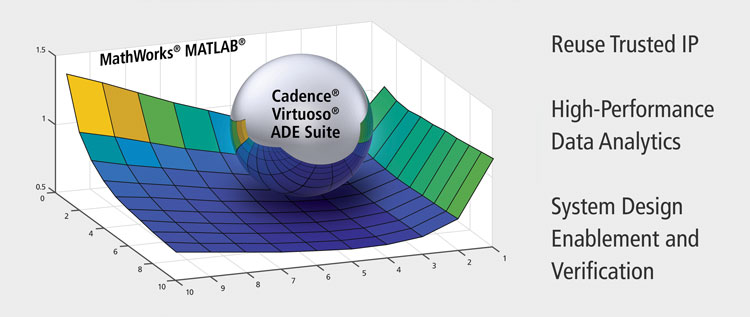Cadence and MathWorks Integrate Virtuoso and MATLAB
Cadence Design Systems has announced it has expanded its partnership with MathWorks through a new integration between the Cadence Virtuoso Analog Design Environment (ADE) Product Suite and MATLAB, enabling customers to accelerate processing of large data sets when verifying custom, RF and mixed-signal designs.
With this integration, designers can take advantage of existing MATLAB scripts and seamlessly share data between the Virtuoso and MATLAB platforms, allowing for data mining and efficient analysis in either platform. This improved connection is intended to decrease time to market when compared to traditional methods.
By working together, and with customers, Cadence and MathWorks created a tight integration between the Virtuoso ADE and MATLAB tools to offer IC designers several new benefits. Using MATLAB’s toolboxes and language, designers can easily create and solve complex data calculations that would have previously taken hours to solve using expert coding knowledge and low-level APIs. Now, this data analysis can be performed in either tool, or split between the two, allowing customers to pick the most efficient manner to get the calculations and answers.
“As system-on-chip designs continue to grow in complexity, it becomes more challenging to analyze the large amount of simulation data that is created during the design and verification process,” said Roy Lurie, Vice President of engineering, MATLAB products. “By integrating MATLAB with the Virtuoso ADE product suite, we have jointly enabled IC designers to analyze and visualize their simulation results in either solution. This can significantly decrease the amount of time engineers spend analyzing their results, decreasing time to market.”
Furthermore, the collaboration allows customers of the Virtuoso ADE product suite and the Cadence Spectre Circuit Simulator to utilize MATLAB scripts to analyze specialized Radio Frequency (RF)-based measurements. These scripts have been refined over the past decade, and can be used for post-simulation data mining and creating complex analysis plots, such as constellation plots, for detecting poor signal quality after demodulation in communications systems.
“For 15 years, Cadence’s Virtuoso and MATLAB from MathWorks have been our tools of choice for automotive ASIC sensor development,” said Jamie Haas, Director of Design Engineering, Advanced Sensor Technologies, at Allegro Microsystems.
“Now that the MATLAB and Virtuoso platforms are inherently compatible, we can easily move between environments and utilize the powerful capabilities of each solution. With ever-increasing product complexity and aggressive schedules, the integration enables thorough verification in the analog domain so that we can meet our time-sensitive deadlines.”
“In support of our System Design Enablement initiative, we created a unique design flow from system through chip implementation and verification using the industry’s two leading design and analysis platforms: the Virtuoso ADE product suite and MATLAB software,” said Tom Beckley, Senior Vice President and General Manager of the Custom IC & PCB Group at Cadence. “Our customers who design automotive ICs, RF communication systems or the latest IoT devices can harness the power of the Cadence and MathWorks integration to simplify the exchange of data and boost analytics capabilities. Together with the previously announced PSpice and MATLAB integration, we have expanded our System Design Enablement offering and connected two key tools to the world’s leading modeling tool.”




Comments are closed, but trackbacks and pingbacks are open.